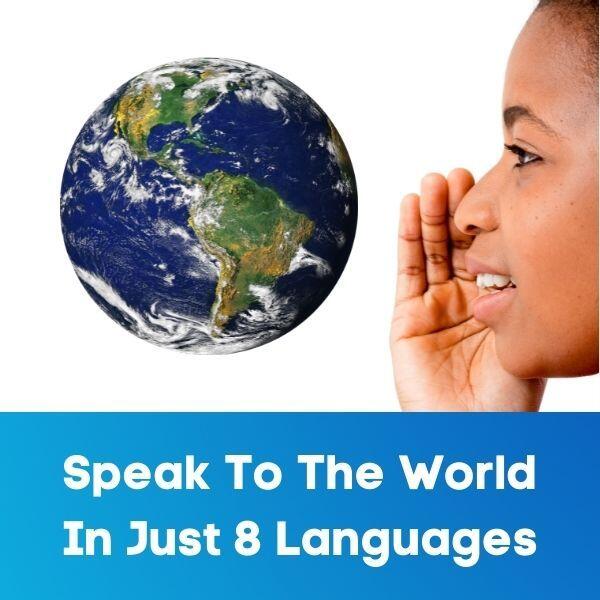Can You Learn A Language In A Day? Challenge Accepted
Is it possible for a person with zero experience in a language to learn enough of it in just one day to have a proper conversation? Well, I wanted to explore this, so I took a one-day language challenge to see just how far I could get. The results might surprise you…
How does the one-day language challenge work?
The one-day challenge pushes you to learn as much as you can of a new language in the space of one day, using whatever tools are available to you. Then, the following day, after you’ve had time to sleep on it, you see how much you’ve actually retained.
This was the first time I’d attempted something like this, but it won’t be the last. I’ve always wanted to try a long cramming session to test my brain capacity.
Language choice
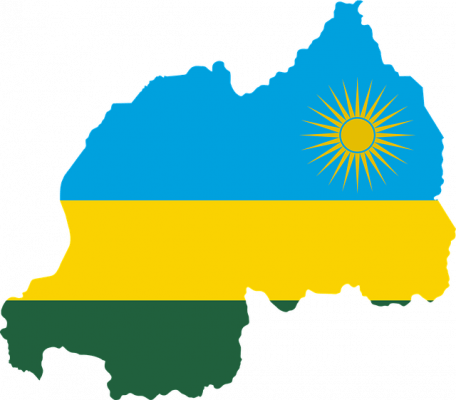
In order to truly challenge myself, I chose a language I had zero experience with, whether directly or indirectly. I chose Kinyarwanda, the official language of Rwanda, Africa. I plan to spend some time in the country in the future, so I have an incentive to learn it.
I should disclose that I made a failed attempt to learn Swahili a while back, which, like Kinyarwanda, is a Bantu language, and does have some slight similarities. However, I remember almost nothing of Swahili, and the languages are still so different that, even if I did, it would have made little difference. This was, for all intents and purposes, a clean slate.
My approach
I knew I needed to create a completely immersive environment, so this meant I had to give up English for the best part of a day (though not completely, which I’ll explain later).
Everything I watched and listened to, no matter what I was doing, had to be in Kinyarwanda. Going into this language especially, I knew this wouldn’t be easy, for the simple fact that there are limited resources available online. For a look at all the challenges associated with learning a language with few resources, check out my post Learning A Language That Lacks Resources.
Preparation
The night before the challenge began, I got together some of the tools and materials I would need, though due to my lack of preparation I still had to find more during the challenge.
A list of all the things I used:
- uTalk Kinyarwanda course – I found a deal and purchased the whole course outright. They’re one of the few places that offer courses in this language and many other hard-to-find languages.
- Rwasibo – a full-length Rwandan thriller available on YouTube
- Live Rwanda Radio Stations – a Rwandan radio app (iOS and Android) with several different stations
- Learn Kinyarwanda – a 9-part introductory Kinyarwanda YouTube course
- Bana Twige – Kinyarwanda children’s channel that teaches colors, animals, numbers etc.
My schedule
| 00:30 | I launched straight into the uTalk course. I’d slept the evening before and was refreshed and ready to go. I worked on a couple of topics for a solid 4 hours. |
| 04:30 | I took a break, because my brain was frazzled, and watched about 3 quarters of Rwasibo, which was entirely in Kinyarwanda. I couldn’t understand a word of it, so following it was difficult. (I won’t go into the production value… that’s a story for another post.) |
| 05:30 | I returned to the uTalk app, put in another couple of hours. |
| 07:30 | I took a nap for 4 hours. But, not wanting to break away from the language for even a second, and wanting to stay immersed, I put on Energy Radio – 88.8 FM, a radio talkshow that’s completely in Kinyarwanda, and occasionally plays afrobeats (though I wasn’t even sure if the music being played was solely Rwandan). |
| 11:30 | I woke up and did a couple more hours on the uTalk app. By then I’d gone through a handful of different topics, though hadn’t completed them. |
| 13:30 | I went to make dinner, which took a couple of hours. Once again, not wanting to stall my learning, I found the 9-part Kinyarwanda course on YouTube, and listened to that 1 and a half times while I prepared my food. |
| 15:30 | During my meal, for about an hour, I watched a few short Kinyarwanda cartoons and nursery rhymes that taught colors and animals. |
| 17:00 | I returned to uTalk. Started briefly working on adjectives. |
| 18:30 | I napped again until 9pm, with the radio playing once more. |
| 21:00 – 22:00 | Woke up, did one more hour on uTalk, then called it a day at 10pm. |
Total hours spent in Kinyarwanda: 21, give or take.
My overall experience
Challenges faced
Let me start off by saying this: I’m convinced that Kinyarwanda was designed never to be learned, understood or spoken by anyone who isn’t Rwandan!
Seriously, I thought Russian was challenging, but this language blows it out of the water. Unnecessary letters everywhere; a million words needed for one English word; words pronounced nothing like they’re spelt, making reading them confusing and unhelpful.
That said, Russian looked exactly like this to me when I first started it. For a native English speaker, if you confine yourself to Latin and Germanic-based languages, you’ll come across many cognates, which makes remembering some of the vocabulary easy. With brand new languages that don’t share those roots, however, it’s all brand new, with the exception of a few loan words here and there.
So, all that to say, this was truly a challenge for me. I have a terrible memory, and seeing as this was basically all about memory, I knew I’d have a hard time with it. I desperately needed to create mnemonics – word association – which I failed to do, thus the words kept drifting out of my short term memory, with no chance of making it to my long term one.
The uTalk course
I started the day off by working through the topics in the order they came, but then stopped after a while and chose more relevant ones to focus on. I realized that some of the lessons made no sense without further knowledge, and the vocabulary simply wouldn’t stick. So I moved on to introductory topics that were easier and more relevant to me.
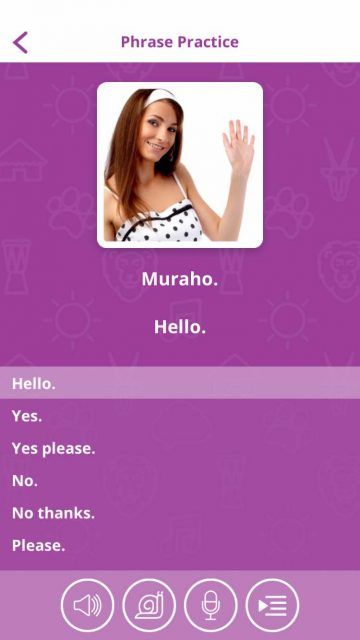
When you start a new topic, you’re encouraged to check out the Phrase Practice section first, which shows you all the words and phrases in the topic, plus their English meanings. You’ll hear how they’re pronounced and see how they’re spelt. You can even slow down the audio speed here, making it easier to decipher what’s being said.
Each word or phrase has a picture associated with it, which helps you remember what it means, because in most games the English translation won’t be available. Once you’ve gone over these a few times, head on over to the games.
Course structure
The gamification approach of the app makes learning quite pleasant. There are 5 games that test different skills. You’re rewarded with points and coins for completing them.

The Easy Game is the first one you should try. You’re shown pictures with their audio, then their positions are mixed up, and you have to match the audio with the correct image.

In Hard Game, you simply have to choose the correct picture to match the audio, though unlike in the easy game you aren’t given any refreshers or the written word, you have to rely on what you’ve learned.

There are a couple of speaking exercises where you record yourself saying the words. In Speaking Game, you match your recordings to the pictures.
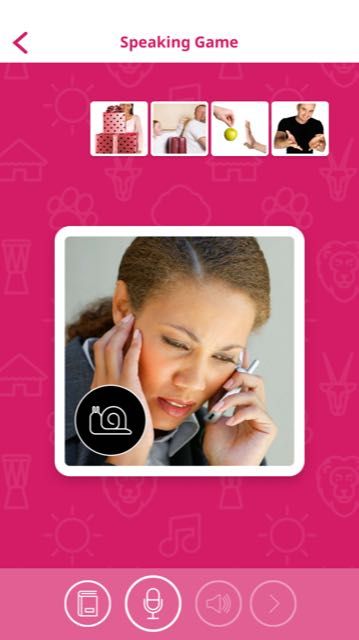
In Recall Game, you say the translation when you see the English equivalent. This is a real test of how much you’ve learned, and is tough but a lot of fun. You’re tasked with marking yourself correct or incorrect upon hearing the right answer from the native recordings.
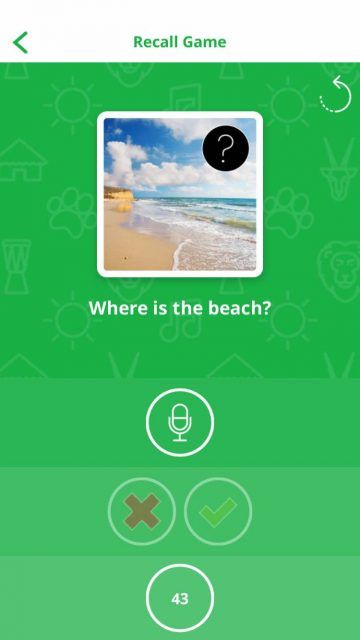
There’s also Memory Game. The less said about that, the better. The first half involves recalling where the pictures are, which is the part I don’t like. The second half, you have to choose the correct pictures to match the audio you hear, whilst a timer runs.

I have my favorites, but in general I played every game multiple times in order to get all-round practice. I don’ think the first half of the memory game tests language skills, however, and for ease I found myself remembering picture positions in English, which sort of defeats the issue.
There are 2 native speaker recordings for every phrase: male and female. This is actually helpful, as you get to hear different pronunciations. However, sometimes they’re too different, and this creates confusion. Is it pronounced as a “j” or a “z”, I often found myself wondering. And which way is correct?
Sometimes the recordings weren’t very clear, either, though I’m not sure whether this was the fault of the app or the language itself.
In general, I found the app quite good in boosting vocabulary. I worked on about 9 different topics, each covering a fair amount of new words – basic, everyday things you’d often encounter.
But I needed to know more about how the sentences were formed. That’s just the way my brain works. I’m a grammar nut; the whys and wherefores aid in my understanding of the language. I went into this app blind. Only once I listened to the YouTube video, explaining how verbs are conjugated in Kinyarwanda, did what I’d learned on the app start to make a teeny weeny bit more sense.
Extra materials
The 9-part video course was in English, but I was fine with that. The instructor, a native speaker, broke things down quite well, starting with the easy verbs – to be and to have. With this, I was able to make sense of some of the stuff I’d learned in the uTalk app. I feel that if I’d watched this prior to working on the app, I would have gotten more out of the whole experience.
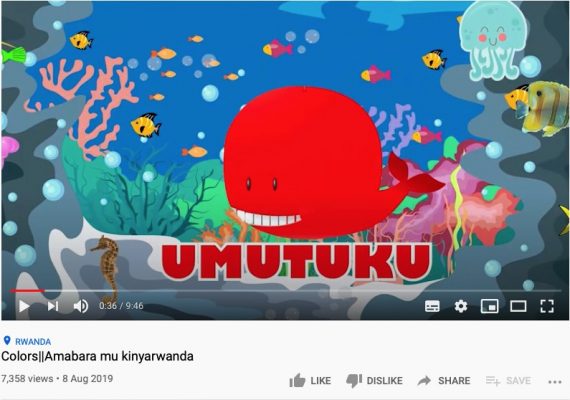
Finding the colors and nursery rhymes videos on YouTube really helped in adding some extra vocabulary in a different way. Apps can get a little boring after a while, so it’s good to mix things up.

The radio and the movie did nothing for me, though I didn’t really expect them to. I had zero knowledge, had been learning for just a few hours, so there was virtually no way I would understand a word beyond murakoze (thanks) and yego (yes). For me, though, having these playing wasn’t so much about the vocabulary but getting used to how the language sounded. It achieved its goal, in that respect.
What did I actually learn?
The line, “In the morning you know you won’t remember a thing”, from “In the Morning” by Razorlight, comes to mind!
Okay, so what I can understand vs what I can actually reproduce myself are two different things. Being able to hear and understand something is much easier than being able to say it. Actually speaking a language requires different skills than simply retaining and being able to understand it when it’s spoken. That’s why many people, especially those whose parents speak another language but didn’t teach them, can understand it but are unable to speak it.
On the face of it, I remember just a handful of things that I’m actually able to say myself. At a liberal estimate, I’d put it at maybe a quarter of what I learned. That number goes up considerably if we’re just talking about what I would understand if I heard it now. So I guess I have stored a lot more than my verbal skills would suggest.
The day also felt longer than it was. It seemed like I’d been studying the language much longer than I had. When I think about how much I covered in such a short space of time, it’s actually pretty remarkable. I’m able to name some body parts, food, family members, and various other bits and bobs that suddenly come to mind.
The most interesting part about this whole thing is, after studying one of my other languages, some of the Kinyarwanda started coming back to me – words I assumed I’d forgotten.
Improvements
I must admit that I wasn’t well prepared. I should have had all of the videos and introductory grammar information ready before I started, but I didn’t. My results might have been better had I known exactly what I would need and what would be lacking.
I needed to learn the introductory verbs “to be” and “to have” right at the beginning, before I learned anything else. That’s just me; other people will be different. If I can’t see how things work, they become too abstract, and thus hard to contextualize and remember.
But because I didn’t really learn that stuff, I’m still unable to easily create my own simple sentences, something most written courses teach you from lesson one. I should have learned how to say, at the very least, what I have or don’t have, stuff like that. This is where some early grammar work comes in handy. Just a couple of hours spent on that would have allowed me to take the nouns I learned and form basic sentences.

I wasted too much time on irrelevant lessons at the start, because I foolishly attempted to go through each lesson in order. I should have stopped earlier and chosen the relevant topics sooner. For instance, learning about things associated with trains in a country like Rwanda that doesn’t have any, is redundant. The lesson titled First Words, naturally, should have come first, followed by Essential Phrases.
The lack of diverse materials hindered me. I would have really appreciated being able to watch something with clear Kinyarwanda subtitles, as that’s how I like to train my brain to understand spoken and written language.
My final thoughts
Was this challenge a success? Can you really learn a language in just one day? Well, I think it was a success in that I know a lot more Kinyarwanda than I did the day before I started. I did start to notice patterns towards the end as well, which was surprising.
But is it possible to learn a language in a day? I think it’s definitely possible to be able to express yourself very simply after just 20 hours of dedicated, targeted study. I’m not able to do that because my approach was flawed. Now that I know what’s required, I’ll do better in the next challenge, on a new language.
If you’re thinking about trying this, you should know that, unless you continue learning once the day is over, none of this is likely to stick. You’ll get a lot more out of this one-day challenge by extending it and adding to your knowledge. Use the day as a launchpad for future study; a foundation, if you will. But go at a much more sustainable pace. Study regularly – an hour or two a day.



